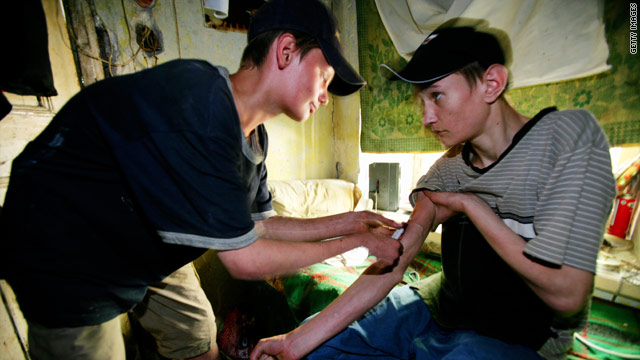
- Eastern Europe, Central Asia are only regions where HIV infection rates increasing
- Street children, especially those using drugs or caught up in sex trade, are especially vulnerable
- Social stigmatization risks driving HIV epidemic underground, report warns
- UNICEF says authorities need to establish "non-judgmental, friendly services"
(CNN) -- Growing numbers of vulnerable children across Eastern Europe and Central Asia are at risk of dying from AIDS,
with widespread drug use and the sex trade contributing to an
"underground HIV epidemic," UNICEF warned on Monday. The former
Soviet states, from Baltic Russia to Tajikistan in Central Asia, and
parts of the Balkans remain the only regions of the world where rates of
HIV infection continue the rise, according to the UNICEF report,
released at an international HIV/AIDS conference in Vienna, Austria.
"Today, street children in the region are dying of AIDS and drug use in much
the same way as they died of cold, famine and typhoid in the twentieth
century," claims the report, entitled "Blame and Banishment."
Newly diagnosed HIV cases increased by eight percent in Russia in 2009, by 10
percent in Georgia and by 22 percent in Belarus, according to figures
released last week by the Joint United Nations Programme on HIV/AIDS
(UNAIDS). Some parts of Russia have experienced a 700 percent increase
in rates of infection since 2006, UNICEF says. Widespread social
stigmatization and discrimination associated also threaten to drive the
epidemic underground, warned UNICEF's regional HIV/AIDS specialist Nina
Ferencic.
"There's an unwillingness to acknowledge that there are young people and minors involved in these behaviors," said Ferencic, a
co-author of the report. "We hope to raise attention to the
issues affecting children and young people who are either vulnerable,
engaging in risky behaviors or already living with HIV and AIDS. These
children need special support and services that reach them."
UNICEF said that street children and children in poverty were particularly at
risk with a third of new cases of HIV infection affecting the 15-24 age
group. Recent research suggests up to 40 percent of homeless children in
the Russian city of St. Petersburg could be infected with the virus.
The problem of street children has increased since the collapse -- along
with the entire Communist system -- of state institutions for orphans
and neglected children in the early 1990s and the subsequent Russian
economic crisis, the report says. While there are no reliable
estimates of the number of children living on the streets, experts
reckon up to one million across the former Soviet bloc are currently
fending for themselves.
For many, that also means exposure to drugs with around 3.7 million people in the region estimated to inject
drugs -- a quarter of the world's total. One in four of those are
estimated to be HIV positive. Many vulnerable adolescents also end up
working in the sex trade, further exposing themselves to the risk of
contracting HIV.
In the study in St. Petersburg, more than half of 319 participants aged 15 to 19 had experience of injecting drug use
and 96 percent were sexually active with a quarter having had more than
six sexual partners per year.
UNICEF Executive Director Anthony Lake said that authorities needed to establish "non-judgmental, friendly
services" to address the needs of marginalized adolescents -- such as
100 youth centers established in Russia to provide reproductive and
sexual health services, counseling and psychological support.
"Children and adolescents living on the margins of society need access to health
and social welfare services, not a harsh dose of disapproval," said
Lake. Even when established, many outreach programs struggle to
win the trust of vulnerable groups with one adolescent female sex worker
at an HIV prevention center in Tajikistan telling researchers she had
initially feared the offer of a free medical checkup and condoms was a
police trap.
Michael Sidibe, Executive Director of UNAIDS, said he was also concerned that some countries appeared to be cutting
investment in HIV programs, especially those targeting injected drug
users.
Coverage of HIV prevention programs in Russia fell from 23.8 percent in 2007 to 13.6 percent in 2009 and in Georgia from 17
percent to 11.4 percent, according to UNAIDS figures. "Epidemics
driven by injecting drug use can grow rapidly when HIV prevention
services are not available," said Sidibe. "Eastern Europe can not lag
behind in the prevention revolution. Evidence shows unequivocally, harm
reduction programs save lives and are a smart investment." Sidibe
also said the spread of HIV/AIDS in eastern Europe and Central Asia
could not be broken without "empowering and protecting" children and
adolescents. "We must not rob them of their childhood," he said.
"It is our responsibility that they have access to HIV prevention and
treatment services."
Speaking to CNN on Monday in Vienna, former U.S. president Bill Clinton urged countries not to
give up on funding AIDS programs, warning that the consequences would be
"calamitous."
Comment
© 2017 Created by Saji Prelis.
Powered by![]()


You need to be a member of Network for Youth in Transition to add comments!
Join Network for Youth in Transition